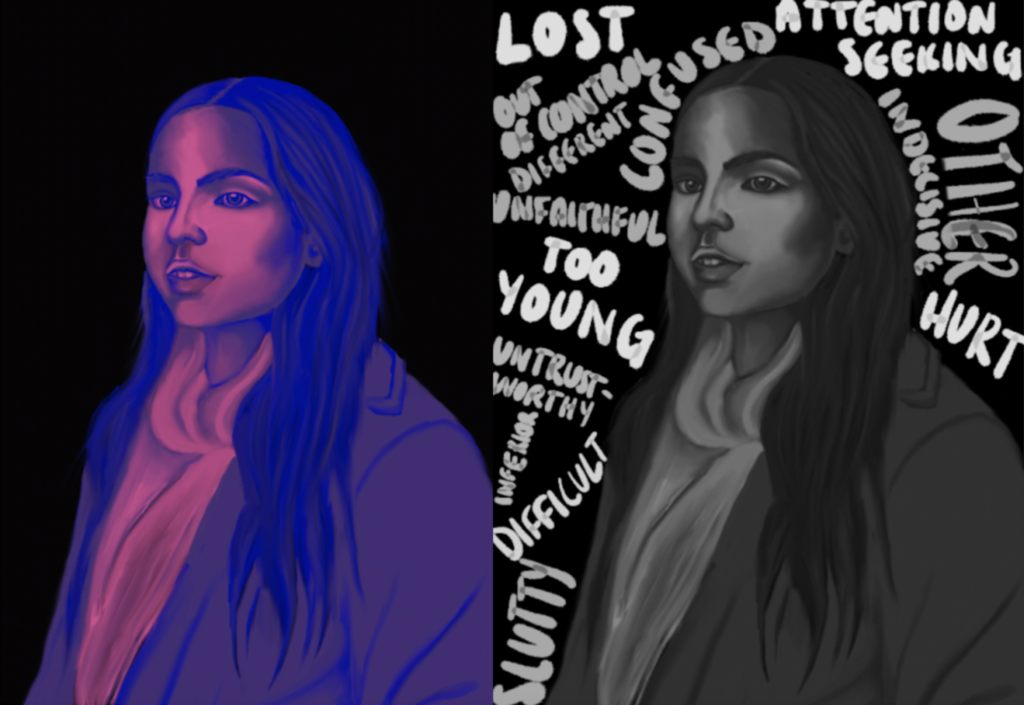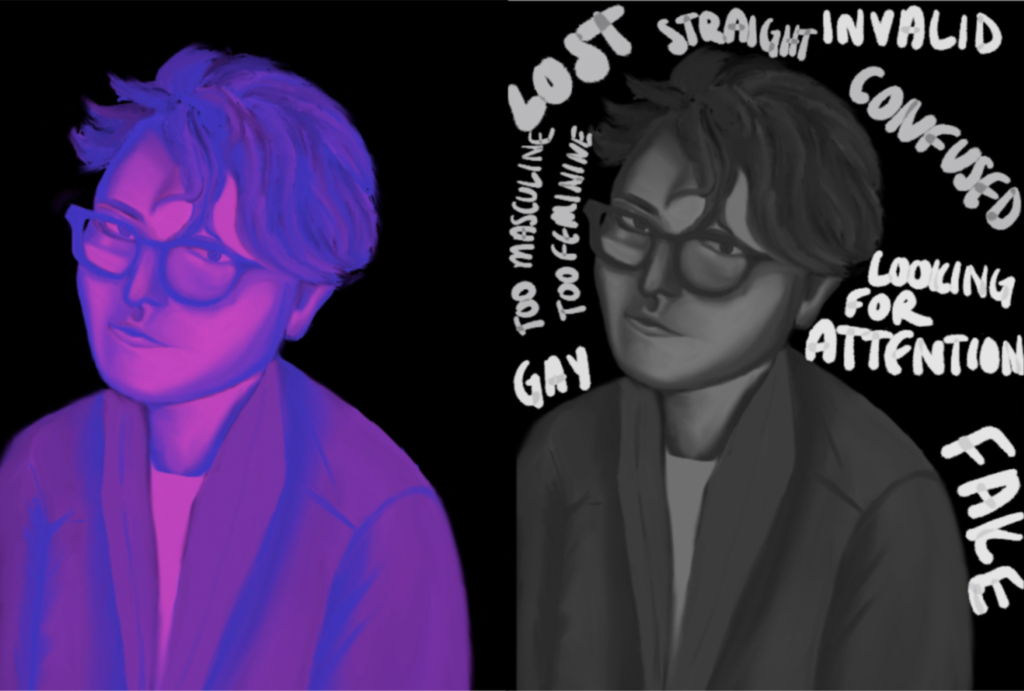

LGTQ+ VS Bisexuals
“You’re in your straight era.”
“You’re in your gay era.”
“If you had to choose only men or women for the rest of your life, what would you choose?”
These are all common phrases people around me have told or asked me. Ever since I’ve come out as bisexual, people have always assumed I’m half straight and half gay. Because bisexuality is seldom represented in popular culture or media, people may not always be aware of what bisexuality is. Instead they may try to reframe it to fit into the mental boxes they’re more comfortable with and already have an understanding of.
When people hear what I identify as, they continuously project binary categories on me because of their lack of awareness. It was no longer about people as individuals, but about their gender and how my sexuality fit or didn’t fit into their sexual categories.
Funnily enough, these comments are more typically from people who identify as LGBTQ+.
Counterintuitively, in the “postgay” era, a time when lesbian and gay people have more freedom and greater autonomy, homonormativity has greatly increased. Homosexuals are often accepted more than bisexual people because gay people are often able to mimic straight people, as they are also only attracted to one gender. Specifically, white, middle and upper class homosexual people can align their lifestyles to heterosexual religious, raced, and classed norms (Mathers et al, 2018).
The presumption that one should be on one end of the sexuality spectrum reinforces monosexism, an oppressive idea that solely supports lesbians, gay men, and heterosexuals, while perpetuating biphobic ideas (Mathers et al, 2018). As homosexuals begin to obtain more respect in the “postgay” era, heteronormativity has converted to monosexism.
Making connections and assuring society that straight and gay people are not that different is important, but more care should be taken to avoid discrediting or forgetting bisexual people or people identifying with other sexualities in these conflicts (Mathers et al, 2018).
How Bisexuals Were Left Behind in the Dominant Narratives of LGBTQ+ Movements and Culture
“I think ‘B’ was added to LG in the later 1980s … In any event the B has rarely (if ever) been taken seriously in my experience.”
Plummer, 2015. Monro et al, 2017.
In the 1980s, the LGBTQ+ rights movement divided itself. Gay men created a subculture for themselves while lesbian women became deeply rooted in the lesbian-feminist movements of the time. The lesbian-feminist movement’s activities included reframing narratives of what sex was defined as, because it was heavily believed that sex was only for a man and a woman. These battles were not the place for bisexual women, who lesbians typically believed did not help to reframe this definition (Seidman, 2015).
Gay culture began making new “sexual codes” that adopted ideas that people were expected to neatly fold themselves into boxes and excluded those without mutually exclusive sexualities. While many bisexual people did not mind this organization, they wanted to feel legitimate within their identities alongside their gay or lesbian peers but because of these codes, bisexual people were often left out of gay and lesbian spheres (Seidman, 2015).
So, where does this leave bisexual people? Do bisexual men join the subculture made by gay men and lack the ability to fully fit in? Do bisexual women continue to be pushed to the sides of important conversations surrounding identity?
Due to the lack of representation for bisexuals, some LGBTQ+ individuals began what’s referred to as “anti-identity politics,” a belief that prevents individuals from including every part of their identity in their self-assigned sexuality (Seidman, 2015). For example, a woman who assigned herself a lesbian will avoid calling herself bisexual even when she feels attracted to men alongside women. Assigning herself a more conventional sexuality that fits into the binary allows her to fit into lesbian spaces, even though she has to hide part of her whole sexuality.
“I have a problem with identifying as bisexual… I do not know what “bisexual” desire would be, since my desire is always for specifically sexed and gendered individuals. When I am with a woman, I love as a woman loves a woman, and when I’m with a man, I love as a woman loves a man. So bisexuality is not a sexual identity at all, but sort of anti-identity, a refusal… to be limited to one object of desire, one way of loving.”
Testimonial from Clausen, J. (1990). seidman, 2015.
This thought of bisexuality dividing into half of each side of the binary is commonly believed and argued. People desire to fit things into boxes they are comfortable with, and are sometimes only able to do this by dividing up fluid identities into binary categories.
The anti-identity approach is still used by bisexual people today.
When my best friend came out as a lesbian, she told me she’d rather not have to label her sexuality. I was initially confused as to why she came out in the first place, so I asked.
She responded with something along the lines of, “my parents will understand this better than if I told them I was bisexual or pansexual. They wouldn’t care if I was gay, but they’d be confused if I was anything else.” This idea frustrated me. Why is it that in such progressive times compared to years ago that anything that isn’t on the extreme ends of the sexuality spectrum is still so misunderstood?
Today, the lack of awareness surrounding fluidity is less prevalent as the relatively new idea of a sexuality spectrum has arisen, but that doesn’t mean ignorance surrounding the subject hasn’t persisted through time (Seidman, 2015).
Bisexual Invisibility and Lack of Recognition
“We’re told that we can’t exist, that we’re really heterosexual or really gay, that nothing exists except these two extremes.”
Testimonial from Hutchins, L., Kaahumanu, L. (1991). seidman, 2015.
Bisexuals still remain far less represented in LGBTQ+ research, texts, and media, perpetuating the idea that it in itself is not an identity on its own, but a confusing mixture of the two extremes, homosexuality and heterosexuality.
Bisexuality almost never appears in social science texts and is often overlooked in sociology. Bisexual invisibility can be extremely dangerous by insinuating that bisexuals are not worthy of research or discussion and are thus considered inferior or non-existent (Monro et al, 2017).
Bisexuality is also invisible in legal marriage rights. Gay rights movements had great success with the Supreme Court ruling in favor of gay marriage. The ruling greatly increased marriage among the LGBTQ+ community in states which granted gay marriage at the state level (Carpenter, 2020). This did not come without opposition, as many people assumed this new freedom would harm children and the traditional institution of heterosexual marriage (Carpenter, 2020). The Surpreme Court ruling, however did change many people’s opinions on gay marriage as it is known that institutions can influence personal thoughts through reasoning and forcing people to think deeply (Tankard & Paluck, 2017).
Gay people were thus beginning to fit into the portrait of what people believed to be the nuclear family. Bisexual people, however, are unable to fit into the nuclear family because they would be considered to either be in a gay or straight marriage. There is no such thing as a bisexual marriage, and just as bisexual people are put into half of the “straight box” and half of the “gay box,” they’re forced to fit into a gay or straight marriage and fluidity is once again lost.
Attraction to more than one gender is not a new concept, but it is often ignored and pushed out of many important conversations surrounding understanding people and identity. Bisexual people are often pushed out of both straight and gay circles because of societal expectations of being attracted to one gender. It is essential to continue pushing for rights for everyone within the LGBTQ+ community rather than dividing it more to encourage visibility and normality for some, but not all.
References
Carpenter, Christopher S. “The Direct Effects of Legal Same-Sex Marriage in the United States: Evidence From Massachusetts.” Demography 1 October 2020; 57 (5): 1787–1808. doi: https://doi.org/10.1007/s13524-020-00908-1
Hunt S and Yip AK-T (2016) The Ashgate Research Companion to Contemporary Religion and sexuality. Routledge.
Mathers, Lain A., J. E. Sumerau, and Ryan T. Cragun. 2018. “The Limits of Homonormativity: Constructions of Bisexual and Transgender People in the Post-Gay Era.” Sociological Perspectives 61(6):934–52.
McCormack, Mark, Eric Anderson, and Adrian Adams. 2014. “Cohort Effect on the Coming out Experiences of Bisexual Men.” Sociology 48(6):1207–23.
Meadow, T. (2018). Trans Kids: Being Gendered in the Twenty-First Century. University of California Press.
Monro, Surya, Sally Hines, and Antony Osborne. 2017. “Is Bisexuality Invisible? A Review of Sexualities Scholarship 1970–2015.” The Sociological Review 65(4):663–81.
Seidman, S. (2015). The social construction of Sexuality. W.W. Norton & Company.
Tankard, M. E., & Paluck, E. L. (2017). The effect of a Supreme Court decision regarding gay marriage on social norms and personal attitudes. Psychological Science, 28(9), 1334–1344. https://doi.org/10.1177/0956797617709594
[@candlejennerofficial]. (2023, April 17). In Between #floptok [Video]. Tiktok. https://www.tiktok.com/t/ZTRwFfoDk/